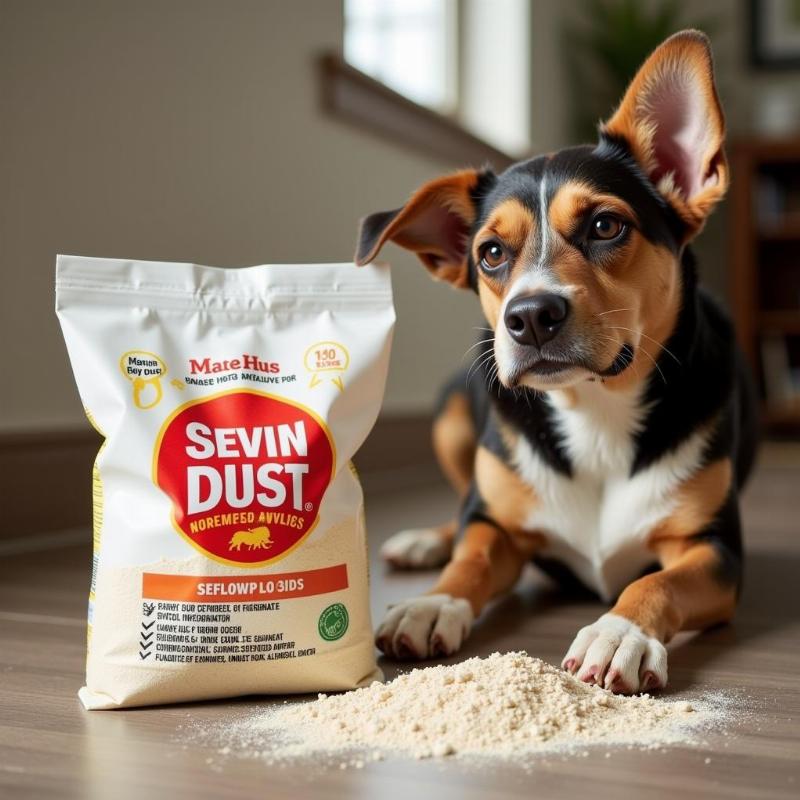Sevin dust is a common insecticide used in gardens and lawns across America. While effective against pests, its use around pets, specifically dogs, raises serious concerns. Can I use Sevin dust on my dog? The short answer is a resounding no. Applying Sevin dust directly to your dog is extremely dangerous and can lead to severe health issues. This article will delve into the reasons why Sevin dust is harmful to dogs, safer alternatives for pest control, and steps to take if your dog is accidentally exposed.
Understanding the Dangers of Sevin Dust for Dogs
Sevin dust’s active ingredient, carbaryl, works by inhibiting an enzyme crucial for nerve function in insects. Unfortunately, this enzyme is also present in mammals, including dogs. While dogs are less sensitive to carbaryl than insects, direct application or ingestion can lead to carbaryl poisoning. Symptoms can range from mild skin irritation and drooling to more severe issues like vomiting, tremors, difficulty breathing, and even seizures. The concentration of carbaryl in Sevin dust is particularly concerning for smaller dogs or puppies, who are more susceptible to its toxic effects. Even indirect exposure, like rolling in treated grass or licking residue off their paws, can be harmful.
 Sevin Dust and a Dog
Sevin Dust and a Dog
Safer Alternatives for Pest Control on Your Dog
Protecting your furry friend from fleas, ticks, and other pests is essential, but there are much safer alternatives to Sevin dust. Veterinarian-approved flea and tick preventatives are readily available in the US and come in various forms, including topical treatments, oral medications, and collars. These products are specifically formulated for dogs and target pests effectively while minimizing the risk of adverse reactions. Always consult with your veterinarian to determine the best preventative for your dog’s breed, age, and health condition. For yard treatments, consider using pet-friendly pest control products or natural solutions like diatomaceous earth, which is safe for both pets and children.
What to Do if Your Dog is Exposed to Sevin Dust
If you suspect your dog has been exposed to Sevin dust, act immediately. First, remove your dog from the area where the insecticide was applied. If Sevin dust is on their fur, bathe them thoroughly with a mild pet shampoo, taking care to avoid getting the lather in their eyes or mouth. Contact your veterinarian or the ASPCA Animal Poison Control Center immediately for further guidance. Prompt treatment is crucial in managing carbaryl poisoning and preventing serious complications.
Preventing Sevin Dust Exposure in Dogs
Prevention is key when it comes to protecting your dog from Sevin dust. If you choose to use Sevin dust in your garden, ensure your dog is kept indoors and away from the treated area until the dust has settled and the area is thoroughly watered. Follow the product instructions carefully and adhere to the recommended waiting period before allowing your dog back into the treated area. Inform family members and guests about the presence of the insecticide and the importance of keeping pets away. Consider posting clear signage in the treated area as an added precaution.
Natural Pest Control Solutions for Your Yard
Beyond commercially available pet-friendly pesticides, several natural methods can help control pests in your yard. These options offer a safer alternative to harsh chemicals like Sevin dust, minimizing the risk to your beloved canine companion. Neem oil, derived from the neem tree, acts as a natural insect repellent and can be applied to plants and surrounding areas. Essential oils like citronella, lavender, and peppermint can also deter pests. Remember to dilute essential oils properly before use and consult with your veterinarian about safe application methods around pets.
Conclusion
While Sevin dust can be an effective insecticide for your garden, it poses a significant risk to your dog’s health. Never apply Sevin dust directly to your dog. Opt for safer, veterinarian-approved pest control methods to protect your furry friend from fleas, ticks, and other pests. If your dog is accidentally exposed to Sevin dust, seek immediate veterinary attention. Prioritizing your dog’s safety and well-being is paramount, and choosing safer alternatives for pest control is a crucial step in responsible pet ownership.
FAQ
- What are the signs of Sevin dust poisoning in dogs? Symptoms can include drooling, vomiting, tremors, difficulty breathing, and seizures.
- What should I do if my dog ingests Sevin dust? Contact your veterinarian or the ASPCA Animal Poison Control Center immediately.
- Are there any natural alternatives to Sevin dust for yard treatment? Yes, options include diatomaceous earth, neem oil, and certain essential oils.
- How long should I keep my dog away from an area treated with Sevin dust? Follow the product instructions and consult with your veterinarian for specific guidance.
- Can I use Sevin dust on my dog’s bedding? Absolutely not. Sevin dust should never be applied directly to your dog or anything they come into close contact with.
- What are some safe flea and tick preventatives for dogs? Consult your veterinarian for recommendations based on your dog’s breed, age, and health. Options include topical treatments, oral medications, and collars.
- Is Sevin dust harmful to other pets? Yes, Sevin dust can be toxic to cats and other animals.
Beautdogs.us is your premier online resource for comprehensive dog care information, breed insights, and product recommendations. We cater to both novice and experienced dog owners, providing expert guidance on all aspects of canine companionship. Explore our website for valuable tips and resources to help you provide the best possible care for your beloved dog. Contact us for personalized advice at [email protected] or call us at +1 501-555-7529. Beautdogs.us is committed to helping you nurture a happy, healthy, and beautiful dog.